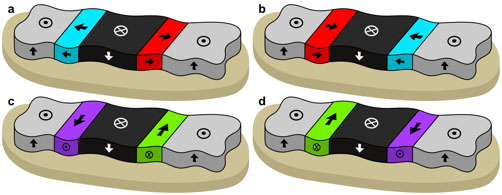‘Spin-orbitronics’ could ‘revolutionize the electronics industry’ by manipulating magnetic domains
April 14, 2015

These schematics of magnetic domain walls in perpendicularly magnetized thin films show (a) left-handed and (b) right-handed Neel-type walls; and (c) left-handed and (d) right-handed Bloch-type walls. The directions of the arrows correspond to the magnetization direction. (credit: Berkeley Lab)
Researchers at the U.S. Department of Energy (DOE)’s Lawrence Berkeley National Laboratory (Berkeley Lab) have found a new way of manipulating the walls that define magnetic domains (uniform areas in magnetic materials) and the results could one day revolutionize the electronics industry, they say.
Gong Chen and Andreas Schmid, experts in electron microscopy with Berkeley Lab’s Materials Sciences Division, led the discovery of a technique by which the “spin textures” of magnetic domain walls in ultrathin magnets can be switched between left-handed, right-handed, cycloidal, helical and mixed structures.
Electronic memory and logic
The “handedness” or “chirality” of spin texture determines the movement of a magnetic domain wall in response to an electric current, so this technique, which involves the strategic application of uniaxial strain, should allow for creating domains walls with desired electronic memory and logic functions.
“The information sloshing around today’s Internet is essentially a cacophony of magnetic domain walls being pushed around within the magnetic films of memory devices,” says Schmid. “Writing and reading information today involves mechanical processes that limit reliability and speed. Our findings pave the way to use the spin-orbit forces that act upon electrons in a current to propel magnetic domain walls either in the same direction as the current, or in the opposite direction, or even sideways, opening up a rich new smorgasbord of possibilities in the field of spin-orbitronics.”
The study was carried out at at the National Center for Electron Microscopy (NCEM), which is part of the Molecular Foundry, a DOE Office of Science User Facility. The results have been reported in a Nature Communications paper titled “Unlocking Bloch-type chirality in ultrathin magnets through uniaxial strain.” Chen and Schmid are the corresponding authors. Other co-authors are Alpha N’Diaye, Sang Pyo Kang, Hee Young Kwon, Changyeon Won, Yizheng Wu and Z.Q. Qiu.
Spin-orbitronics
In addition to carrying a negative electrical charge, electrons also carry a quantum mechanical property known as “spin,” which arises from tiny magnetic fields created by their rotational momentum. For the sake of simplicity, spin is assigned a direction of either “up” or “down.”
Because of these two properties, a flow of electrons creates both charge and spin currents. Charge currents are well understood and serve as the basis for today’s electronic devices. Spin currents are just beginning to be explored as the basis for the emerging new field of spintronics. Coupling the flows of charge and spin currents together opens the door to yet another new field in electronics called “spin-orbitronics.” The promise of spin-orbitronics is smaller, faster and far more energy efficient devices through solid-state magnetic memory.
The key to coupling charge and spin currents lies within magnetic domains, regions in a magnetic material in which all of the spins of the electrons are aligned with one another and point in the same direction – up or down. In a magnetic material containing multiple magnetic domains, individual domains are separated from one another by narrow zones or “walls” that feature rapidly changing spin directions.
There are two types of magnetic domain walls known to exist in magnetic thin films: Bloch, in which electron spin rotates like a helical spiral around an axis; and Neel, in which electron spin rotates like a cycloidal spiral. Both types of walls can have either right-handed or left-handed chirality.
Switching handidness
Applying a technique called “SPLEEM,” for Spin-Polarized Low Energy Electron Microscopy, to a thin-film of iron/nickel bilayers on tungsten, Chen and Schmid and their collaborators were able to stabilize domain walls that were a mixture of Bloch and Neel types. They also showed how the chirality of domain walls can be switched between left-and right-handedness. This was accomplished by controlling uniaxial strain on the thin films in the presence of an asymmetric magnetic exchange interaction between neighboring electron spins.
“Depending on their handedness, Neel-type walls are propelled with or against the current direction, while Bloch-type walls are propelled to the left or to the right across the current,” Chen says. “Our findings introduce Bloch-type chirality as a new spin texture and might allow us to tailor the spin structure of chiral domain walls. This would present new opportunities to design spin–orbitronic devices.”
“Magnetization is a 3D vector, not just a scalar property and in order to see spin textures, the three Cartesian components of the magnetization must be resolved,” Schmid says. “Berkeley Lab’s SPLEEM instrument is one of a mere handful of instruments worldwide that permit imaging all three Cartesian components of magnetization. It was the unique SPLEEM experimental capability that made this spin-orbitronics research possible.”
This research was supported by the DOE Office of Science.
Abstract of Unlocking Bloch-type chirality in ultrathin magnets through uniaxial strain
Chiral magnetic domain walls are of great interest because lifting the energetic degeneracy of left- and right-handed spin textures in magnetic domain walls enables fast current-driven domain wall propagation. Although two types of magnetic domain walls are known to exist in magnetic thin films, Bloch- and Néel-walls, up to now the stabilization of homochirality was restricted to Néel-type domain walls. Since the driving mechanism of thin-film magnetic chirality, the interfacial Dzyaloshinskii–Moriya interaction, is thought to vanish in Bloch-type walls, homochiral Bloch walls have remained elusive. Here we use real-space imaging of the spin texture in iron/nickel bilayers on tungsten to show that chiral domain walls of mixed Bloch-type and Néel-type can indeed be stabilized by adding uniaxial strain in the presence of interfacial Dzyaloshinskii–Moriya interaction. Our findings introduce Bloch-type chirality as a new spin texture, which may open up new opportunities to design spin–orbitronics devices.